There are several memorials throughout west Wales which commemorate men who died in smaller scale campaigns, or who died whilst serving with the armed forces in the years prior to the Great War. There are also many Pre WW1 war graves in Pembroke Dock Military Cemetery that are already on the website, which I haven’t included here. This page will hold details of some individual memorials, whether in the form of fine marble memorials inside local Churches, or gravestone markers in overgrown cemeteries, which are dedicated to servicemen who died before 1914.
Camrose Church
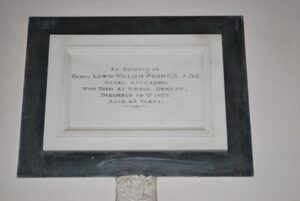
Lewis William Penn, CB, ADC, Colonel, Royal Artillery. Lewis was born in Camrose in 1829, the son of Richard and Emma Penn. He was gazetted into the Royal Artillery on 18 December 1847, and began a lifetime of service with the army. He married Ann Eliza Callen on 22 December 1853. He served during the Crimean War as an Assistant Engineer with the siege train in the trenches before Sebastopol, and at the bombardments of 17 October, 9 April, and on 6 and 17 June. He was also at the battle of Inkerman, and was awarded the Crimean Medal with two Clasps, Brevet of Major, the Sardinian and Turkish Crimean medals, and the Turkish Order of the Medjidie 5th Class for his work there. He later commanded a Mountain Battery throughout the Abyssinian campaign from 29 December 1867 and was present at the action of Arogee and the capture of Magdala, for which he was mentioned in dispatches, created Companion of the Order of the Bath on 14 August 1868, and awarded the Abyssinian Medal. He was promoted lieutenant-colonel from 1 April 1872, and Brevet Colonel on 23 January 1875. He was created a Companion of Bath on 14 August 1868. He died whilst on active service at Kirkee, Bombay, India on 14 December 1879, aged 49. There is a marble memorial plaque to Colonel Penn within Camrose Church.
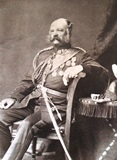
Gumfreston Churchyard
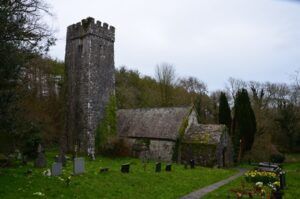
Morgan Crofton Lloyd, Captain, Army Service Corps. Morgan was born in Ireland in 1876, the son of Colonel Morgan George Lloyd, CB, and Emily Olivia Lloyd (nee Bell), of Belvedere, Tenby. He was commissioned into his father’s battalion, the 3rd Battalion, Royal Irish Regiment, but was gazetted to the Army Service Corps on 2 May 1900, and served in South Africa. He had become ill, and was invalided home. He married Alice Sheriffe Bromwich, of Rugby, and they had a son, Malcolm Henry. Morgan died at Tenby in 1908, aged 32. He is buried in Gumfreston Churchyard.
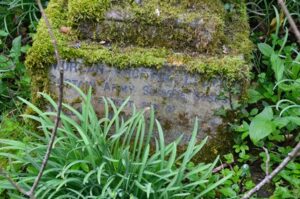
Lone Gravestone in Haroldston Churchyard
In a prominent position against the wall of the Church is a striking headstone which commemorates the memory of Alfred Mathias. Alfred was the son of William and Catherine Mathias, of Mill Cottage, Haroldston, Pembrokeshire. He enlisted into the army, and was living at Hyde Park Barracks when he died on 12 March 1853, aged 21. He was buried in Kensington on 17 March, but his parents erected a slate memorial headstone to him in Haroldstone Churchyard. The photograph is courtesy of Dai Phillips.
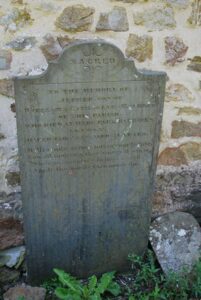
The tombstone records: “Sacred to the memory of Alfred son of William and Catherine of this parish who died at Hyde Park barracks London March 12th 1853 aged 21 years. ‘My friends grieve not my early state. You all must try this untry’d state. When my memory brings a sigh apply the words I too must die.’ Buried in the Kensington Brompton District March 17. Shown as living in the Barracks Knightsbridge.
Llanglydwen, St Cledwyn’s Churchyard
David Garrick Protheroe, Brevet Major, 6th Royal Regiment. David was born at Dolwilym, Llanglydwen on 1 January 1835, the son of William Garrick Bridges Schaw Protheroe and Emma Hart Protheroe. He became an Ensign in the 12th Regiment of Foot on 10 April 1855. On 28 January 1862 he became Captain by purchase with the 6th Regiment of Foot. He married Catherine Annie Lewis in Hampshire on 15 October 1874. On 28 April 1875 he was promoted Major, and on 12 May that year retired from the army, retaining the rank of Major. He died at Llanstadwell on 28 November 1879, aged 44, and was buried in Llanglydwen Churchyard.
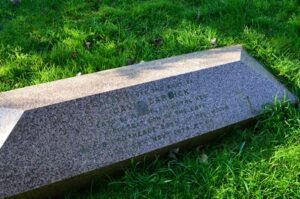
Edward Schaw Protheroe, JP, DL, Surgeon Major, Army Medical Department. Edward was born at Hampton St Mary, Middlesex in 1822, the son of William Garrick Bridges Schaw Protheroe and Emma Hart Protheroe. He trained as a surgeon, and entered the Army Medical Department as Assistant Surgeon on 10 June 1845. Edward served with the Royal Artillery during the Crimean War from 30 October 1854, and was at the Battle of Inkerman and the siege and fall of Sebastopol. He was promoted to Surgeon on 16 March 1855, and married Ellen Augusta Cecilia Beynon on 2 July 1859. On 10 June 1865 he was promoted Surgeon Major, and retired on 19 October 1872, retaining the rank of Honorary Deputy Inspector General. He died at Dolwilym on 4 January 1907, aged 83, and was buried in Llanglydwen Churchyard.
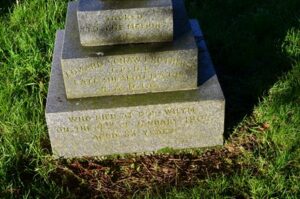
Frederick Jones Schaw Protheroe, Commander, Royal Navy. Frederick was born at Amroth on 3 July 1827, the son of William Garrick Bridges Schaw Protheroe and Emma Hart Protheroe. In 1848 he passed his seamanship certificate, and on 12 June 1849 was gazetted as Lieutenant with the Royal Navy. He had served aboard the 14 gun sloop HMS Niger as a Lieutenant during the Crimean War. On 1 April 1870 he was placed on the retired list, assuming the rank of Commander. He died on 15 June 1874, aged 47 and is buried in Llanglydwen Churchyard.
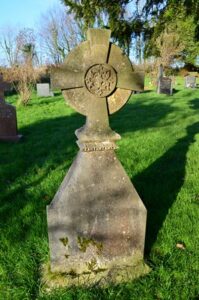
Tenby, St. Mary’s Church
The War of the Austrian Succession
The War of the Austrian Succession began during 1744, when the French began a series of offensives which lead to the capture of most of Flanders. The fortress towns of Menin, Ypres, and Knocke fell in June, while Furnes was taken in July. In an attempt to counter the French threat, major supply and ammunition depot magazines were set up for the British by General Ligonier at Ghent, Oudenarde and Tournai, while the Dutch General Vander-Duyn set up depots at Mons, Charleroi and Tournai.
The Battle of Fontenoy was fought around the village of that name on 11 May 1745, near the town of Tournai which the French aimed to capture. An Allied army under the command of the Duke of Cumberland, and consisting of mainly Dutch, British, and Hanoverian troops, took to the field against a French army commanded by Maurice de Saxe, commander of King Louis XV’s forces in the Low Countries.
The battle was one of the most important during the War, and resulted in a famous victory for the French, whose monarch, Louis XV was present on the field of battle, and heralded the beginning of a glorious phase in France’s military history.
Among the forces present for the British was the 23rd Regiment of Foot, later known as the Royal Welch Fusiliers. The second in command of the regiment during the battle was Major Roger Lort, of Prickeston, Tenby.
Lort was the son of George Lort, of Prickeston. He was commissioned lieutenant on 11 April 1708, joining the 23rd Regiment of Foot as captain on 16 July 1730 from the disbanded 35th Regiment of Foot. He had married Ann, only daughter of Reverend Edward Jenkins, vicar of Fareham, Hampshire and they had six children.
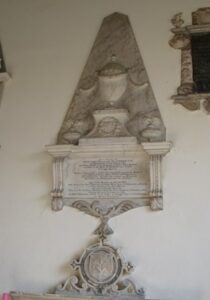
He was promoted major on 18 April 1743 and was fifty one years old when he was wounded and taken prisoner at Fontenoy on 11 May 1745. His son, himself an officer with the regiment, was captured with him and witnessed the French doctors cutting off his fathers’ injured leg. Major Lort died later that day. There is a fine marble war memorial dedicated to him and his family within St. Mary’s Church at Tenby. The Lorts were the Lords of Stackpole, and had taken an active role in the English Civil War. Roger was actually listed at the time as being missing, and was later found to have been dead. On that one day, the 23rd lost 190 men dead, 87 wounded, and 47 missing. The white marble memorial has the following inscribed on it;
“To the Memory of Roger Lort Esq., youngest son of George Lort of Prickeston in this County, Esq., who, being Major of the regiment of Royal Welsh Fusiliers, was killed at the Battle of Fontenoy near Lisle A.D. 1745, aged 51 years.
“During a long residence in this Town, he discharged all the duties of a good Husband, Father, Master, Friend and Magistrate, and united in his character the various excellencies of the Soldier the Gentleman and the Christian.
“Also to the memory of Ann his Wife, only child of the Reverend Edward Jenkins, M.A.; Vicar of Fareham in Hants. A Pious, Prudent, Excellent Woman who died A.D. 1767, Aged 69. They had Six Children, Michael, Roger, Ann, George, Edward, John, of whom the only survivor in 1778, the Reverend Michael Lort B.D., Fellow of Trinity College in Cambridge erected this Monument.”
Ystrad Aeron Church, Ceredigion
SACRED TO THE MEMORY OF JOHN CROSBY VAUGHAN OF BRYNOG AND GREENGROVE IN THE COUNTY OF CARDIGAN ESQUIRE CAPTAIN IN HER MAJESTY’S 38TH REGIMENT WHO SERVED FROM THE COMMENCEMENT OF THE CRIMEAN CAMPAIGN AND DIED JUNE 16TH 1855 OF A WOUND RECIEVED IN THE ADVANCED TRENCH OF THE BRITISH LEFT ATTACK BEFORE SEBASTAPOL AGED 25 YEARS. BELOVED AND HONOURED FOR MANY NOBLE QUALITIES BRAVE AND ZEALOUS IN HIS PROFESSIONAL CAREER HE FELL IN THE GALLANT DISCHARGE OF HIS DUTY AND IS MOURNED FOR IN DEATH AS HE WAS VALUED IN LIFE AS ONE OF THE BEST AND TRUEST OF BROTHERS AND FRIENDS.
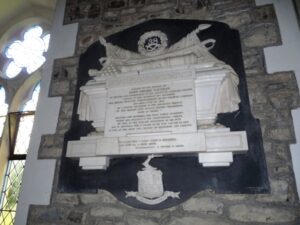
Captain John Crosby Vaughan, was killed in action on 16 June 1855, whilst serving with the 38th Regiment of Foot (1st Staffordshire). In early 1854 the 38th Regiment was short of its official strength, so was authorised to recruit an additional 200 men and was made ready for deployment as part of the Eastern Expedition. Colonel Sir John Campbell was appointed Brigadier, Lieutenant-Colonel J.J. Louth Commander of the Regiment with Brevet Lieutenant-Colonel Sparks his second-in-command, the Regiment consisted of HQ, grenadier, Light and numbers 1 to 6 companies, with them would travel 23 women, 12 horses and 3 civilian servants. On the 24th of April the first five companies of the 38th embarked on the steamer Melbourne without ceremony, followed by the remaining three soon after on the steamer Megara, all companies landed at Gallipoli during May. At Gallipoli the 38th were inspected by the French Commander-in-Chief Marshal de St. Arnaud, and had the pleasure of forming a Guard of Honour for the Turkish War Minister. On the 22nd June the Regiment moved to Varna and at Scutari were issued with the new deadly accurate Minie rifle, finally on the 14th September they were sent to the Crimea, twenty eight miles from Sevastopol, the capture of which was the main allied war aim. Due to bad weather the disembarkation from the ships was not completed until the 16th and the troops had to suffer the terrible weather conditions being drenched in the rain without shelter, food or drinking water. Inkerman With the siege of Sevastopol underway, a number of the 38th were to take part in the Battle of Inkerman. On the 5th of November under foggy conditions the Russians launched a surprise attack on the British entrenchments. After fierce fighting the British made a series of counter-attacks and as the fog lifted more regiments entered the fray, superior fire-power inflicted severe casualties on the Russians, and after the French attacked their flank the Russians were forced to withdraw. Although not all members of the 38th were involved, the Regiment was awarded the Battle Honour ‘Inkerman’. Sevastopol The siege of Sevastopol continued with the troops suffering in the harsh winter conditions, on the 21st of December the Russians made another sortie attacking a detachment of the 50th (West Kent) Regiment. Two companies of the 38th were sent to reinforce, them launching a charge at the enemy forces driving them back and inflicting considerable losses on them, four soldiers of the 38th were killed during the engagement. Awards and Casualties The men of the 38th Regiment received the Crimea Medal with many being entitled to three clasps ‘Alma’, ‘Inkerman’ and Sebastopol. However approximately 40 were present at Balaklava, so entitling those to this clasp also. Some fifteen Distinguished Conduct Medals were awarded to other ranks, while a number of officers received French and Turkish awards. A total of three officers and forty three other ranks were killed in action and two hundred and seventeen wounded, another two officers and four hundred men died for various reasons during the campaign while a further twenty three officers and two hundred and sixty men were invalided home, nine men were captured by the enemy and eight were convicted of desertion. The Regiment left Balaklava for England on the 26th June 1856 on HMS Caser with a total strength of eight hundred and fifty, less than half its original strength.